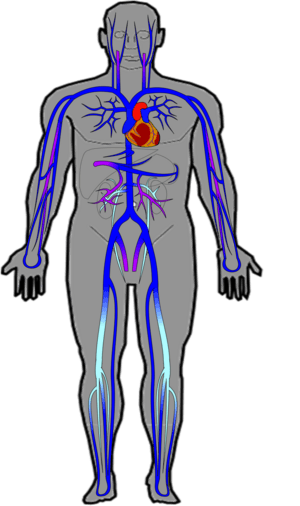Vein facts for kids
A vein is a type of blood vessel in the body. All veins carry blood to the heart. Most veins carry blood that is low in oxygen, except for the pulmonary vein and the umbilical veins which carry blood that is high in oxygen.
A vein has a large lumen (width) and less pressure than an artery. There are smaller amounts of smooth muscle and elastic fibres in the vessel wall. Most veins have one-way valves that keep blood from going backwards.
Veins carry blood to the heart and move to the heart through the vena cava, the biggest vein in human body Other important veins are the coronary veins(veins on the heart) and renal veins(veins on the kidney). Veins are mainly seen just below the skin, and could easily be seen from the outside, where they look blue because of the lack of oxygen. The blood carried by veins is dark red, but when a vein is cut or pierced, the dark blood immediately reacts with the oxygen in the air and becomes bright red colored. The vein appears blue because of the scattering of light through the skin and the way the eye perceives color and light.
Images for kids
-
Human anatomical chart of blood vessels, with heart, lungs, liver and kidneys included. Other organs are numbered and arranged around it. Before cutting out the figures on this page, Vesalius suggests that readers glue the page onto parchment and gives instructions on how to assemble the pieces and paste the multilayered figure onto a base "muscle man" illustration. "Epitome", fol.14a. HMD Collection, WZ 240 V575dhZ 1543.
-
Image of veins from William Harvey's Exercitatio Anatomica de Motu Cordis et Sanguinis in Animalibus
See also
 In Spanish: Vena para niños
In Spanish: Vena para niños





